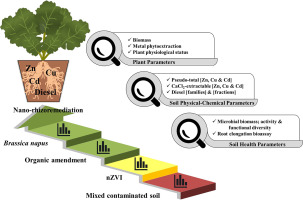Science of the Total Environment ( IF 9.8 ) Pub Date : 2017-11-10 , DOI: 10.1016/j.scitotenv.2017.10.334 Rafael G. Lacalle , María T. Gómez-Sagasti , Unai Artetxe , Carlos Garbisu , José M. Becerril

|
Contaminated soils are frequently characterized by the simultaneous presence of organic and inorganic contaminants, as well as a poor biological and nutritional status. Rhizoremediation, the combined use of phytoremediation and bioremediation, has been proposed as a Gentle Remediation Option to rehabilitate multi-contaminated soils. Recently, newer techniques, such as the application of metallic nanoparticles, are being deployed in an attempt to improve traditional remediation options. In order to implement a phytomanagement strategy on calcareous alkaline peri-urban soils simultaneously contaminated with several metals and diesel, we evaluated the effectiveness of Brassica napus L., a profitable crop species, assisted with organic amendment and zero-valent iron nanoparticles (nZVI). A two-month phytotron experiment was carried out using two soils, i.e. amended and unamended with organic matter. Soils were artificially contaminated with Zn, Cu and Cd (1500, 500 and 50 mg kg− 1, respectively) and diesel (6000 mg kg− 1). After one month of stabilization, soils were treated with nZVI and/or planted with B. napus. The experiment was conducted with 16 treatments resulting from the combination of the following factors: amended/unamended, contaminated/non-contaminated, planted/unplanted and nZVI/no-nZVI. Soil physicochemical characteristics and biological indicators (plant performance and soil microbial properties) were determined at several time points along the experiment. Carbonate content of soils was the crucial factor for metal immobilization and, concomitantly, reduction of metal toxicity. Organic amendment was essential to promote diesel degradation and to improve the health and biomass of B. napus. Soil microorganisms degraded preferably diesel hydrocarbons of biological origin (biodiesel). Plants had a remarkable positive impact on the activity and functional diversity of soil microbial communities. The nZVI were ineffective as soil remediation tools, but did not cause any toxicity. We concluded that rhizoremediation with B. napus combined with an organic amendment is promising for the phytomanagement of calcareous soils with mixed (metals and diesel) contamination.
中文翻译:

甘蓝型油菜在根际修复中对被金属和柴油污染的土壤的健康恢复具有关键作用
受污染的土壤通常特征在于同时存在有机和无机污染物,以及不良的生物和营养状况。根际修复是植物修复和生物修复的结合使用,已被提议作为温和修复方案来修复多污染土壤。近来,正在尝试使用诸如金属纳米颗粒的应用之类的较新技术,以试图改善传统的修复方法。为了在同时被几种金属和柴油污染的钙质碱性城市郊区土壤上实施植物管理策略,我们评估了甘蓝型油菜的有效性L.是一种有利可图的农作物,辅以有机改良剂和零价铁纳米颗粒(nZVI)。用两种土壤进行了为期两个月的光电子加速器实验,即用有机质进行改良和未改良。土壤被Zn,Cu和Cd(分别为1500、500和50 mg kg -1)和柴油(6000 mg kg -1)人工污染。稳定1个月后的土壤用的nZVI治疗和/或种植有乙。那不勒斯。实验由以下因素的组合进行了16种处理:修正/未修正,污染/未污染,已种植/未种植以及nZVI / no-nZVI。在实验的几个时间点确定了土壤理化特性和生物学指标(植物性能和土壤微生物特性)。土壤的碳酸盐含量是固定金属以及降低金属毒性的关键因素。有机改性剂对于促进柴油降解并改善B的健康和生物量至关重要。那不勒斯。土壤微生物优选降解生物来源的柴油碳氢化合物(生物柴油)。植物对土壤微生物群落的活性和功能多样性具有显着的积极影响。nZVI作为土壤修复工具无效,但没有引起任何毒性。我们得出的结论是,用B进行根治性治疗。甘蓝型油菜与有机改良剂的结合有望用于混合(金属和柴油)污染的石灰质土壤的植物管理。


























 京公网安备 11010802027423号
京公网安备 11010802027423号